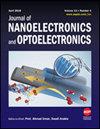Analysis of Electrical Characteristics of N-Doped TiO2 and Si Heterojunction Diodes
IF 0.6
4区 工程技术
Q4 ENGINEERING, ELECTRICAL & ELECTRONIC
引用次数: 0
Abstract
Heterojunction photodiodes play a crucial role in various industries and daily life. They find application in fields such as photoelectric detection, aerospace, and intelligent manufacturing. In this study, we employed a series of growth processes, including physical vapor deposition techniques such as magnetron sputtering, high-temperature annealing, and hydrothermal growth, to fabricate N-doped TiO2 heterojunction diode devices with Si as a substrate material. The surface of the device exhibited a columnar array structure with rutile phase TiO2. Additionally, the doping of N element led to the bending of the energy band of TiO2 by approximately 0.2 eV, and the Fermi level also shifted to the valence band, without any effect on the band gap. The I–V characteristics varied in vacuum and air, with ideal factors (η) of 4.1 and 8.72, respectively. The study is expected to broaden the application scope of doped photodiodes.N掺杂TiO2和Si异质结二极管的电学特性分析
异质结光电二极管在各种工业和日常生活中发挥着至关重要的作用。它们在光电探测、航空航天和智能制造等领域得到了应用。在本研究中,我们采用磁控溅射、高温退火、水热生长等物理气相沉积技术,制备了以Si为衬底材料的n掺杂TiO2异质结二极管器件。器件表面呈现金红石相TiO2柱状阵列结构。此外,N元素的掺杂导致TiO2的能带弯曲约0.2 eV,费米能级也转移到价带,但对带隙没有影响。在真空和空气中,合金的I-V特性不同,理想因子η分别为4.1和8.72。该研究有望拓宽掺杂光电二极管的应用范围。
本文章由计算机程序翻译,如有差异,请以英文原文为准。
求助全文
约1分钟内获得全文
求助全文
来源期刊

Journal of Nanoelectronics and Optoelectronics
工程技术-工程:电子与电气
自引率
16.70%
发文量
48
审稿时长
12.5 months
 求助内容:
求助内容: 应助结果提醒方式:
应助结果提醒方式:


